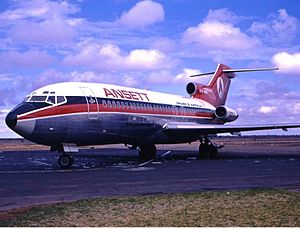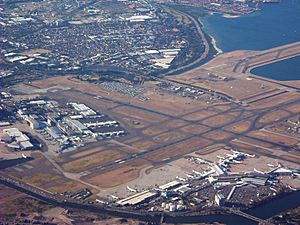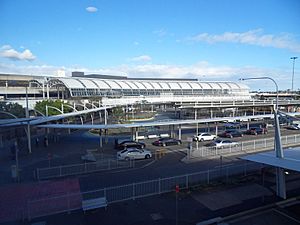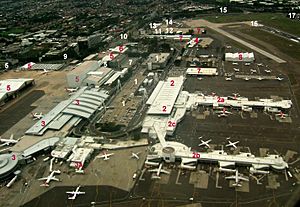Sydney Airport facts for kids
Quick facts for kids
Sydney (Kingsford Smith) Airport
Kingsford-Smith Airport
|
|||||||||||||||||||
|---|---|---|---|---|---|---|---|---|---|---|---|---|---|---|---|---|---|---|---|
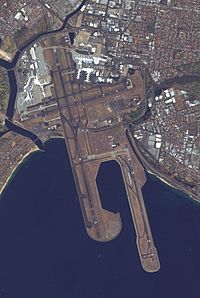 |
|||||||||||||||||||
| Summary | |||||||||||||||||||
| Airport type | Public | ||||||||||||||||||
| Operator | Sydney Airport Corporation Limited | ||||||||||||||||||
| Serves | Sydney | ||||||||||||||||||
| Location | Mascot, Sydney, Australia | ||||||||||||||||||
| Hub for |
|
||||||||||||||||||
| Elevation AMSL | 21 ft / 6 m | ||||||||||||||||||
| Website | www.sydneyairport.com | ||||||||||||||||||
| Runway | |||||||||||||||||||
|
|||||||||||||||||||
| Statistics (2010) | |||||||||||||||||||
|
|||||||||||||||||||
|
Source: AIP
|
|||||||||||||||||||
Sydney (Kingsford Smith) Airport is also called Kingsford-Smith Airport or just Sydney Airport. It is located in Mascot, a suburb of Sydney, Australia. This airport is Sydney's main airport. It is a major base for Qantas and an important base for Virgin Australia and Jetstar Airways. The airport is right next to Botany Bay. It has three runways for planes to take off and land.
Sydney Airport is one of the oldest airports in the world that is still being used. It is the busiest airport in Australia. In 2010, about 36 million passengers used the airport. In 2009, there were 289,741 aircraft movements (take-offs or landings). This made it the 28th busiest airport in the world in 2009. The airport is managed by a company called Sydney Airport Corporation Limited (SACL). You can fly from Sydney to all parts of Australia. There are direct flights to 47 Australian cities and towns.
Contents
History of Sydney Airport
How the Airport Started (1920s-1930s)
Before the airport was built, the land was a field where bullocks (male cows) grazed. A former pilot from World War I named Nigel Love wanted to build airplanes. He needed a place to build a factory and an airport close to the city. He found some land that belonged to the Kensington Race Club. This land had been used by a local abattoir (a place where animals are killed for meat) to feed sheep and cattle.
The land was very flat and covered with buffalo grass. The sheep and cattle had grazed the grass so evenly that it was easy to make it suitable for planes to land. Also, there were no tall buildings or trees around the field. This meant planes could land safely from any direction. Nearby were a racecourse, gardens, a river, and Botany Bay.
Nigel Love started Mascot Airport as his own business. He leased (rented) about 0.8 square kilometers (200 acres) from the Kensington Race Club for three years. At first, he had a small canvas tent. Later, he put up a metal hangar (a building for airplanes). The first flight from Mascot was on November 19, 1919. Love took a movie cameraman named Billy Marshall up in an Avro plane. The airport officially opened on January 9, 1920, with another flight by Love.
In 1921, the Australian government bought about 0.65 square kilometers (161 acres) in Mascot. They wanted to create a public airfield. In 1923, after Love's lease ended, the government took over the land from the racing club. Regular flights began in 1924.
Growing Bigger (1930s-1960s)
In 1933, the first gravel runways were built. To make more space for the airport, the path of Cooks River was moved between 1947 and 1952. Other small streams were filled in. When Mascot was first called an airport in 1920, it was known as Sydney Airport. In 1953, it was renamed Sydney (Kingsford Smith) Airport. This was to honor Charles Kingsford Smith, a famous Australian pilot who was a pioneer in aviation.
The first paved runway was 07–25. The next one built was 16R, which extended into Botany Bay. This started in 1959 to allow large jet planes to land. Runway 07-25 is mostly used by smaller planes. However, large four-engine jet planes still land on it from the east when strong south-westerly winds blow in Sydney. Runway 16R is currently the longest working runway in Australia. It is about 3,962 meters (12,999 feet) long.
New Terminals and Runways (1960s-2000)
By the 1960s, Sydney Airport needed a new international terminal (a building where passengers get on and off planes). Work began in late 1966. The new building was officially opened on May 3, 1970, by Queen Elizabeth II.
The first Boeing 747 "Jumbo Jet" to land at the airport arrived on October 4, 1970. It was Pan American's Clipper Flying Cloud. In the 1970s, the north-south runway was made longer. It became one of the longest runways in the Southern Hemisphere (the half of the Earth south of the equator). The international terminal was made bigger in 1992 and has been updated many times since.
Having only two runways that crossed each other became a problem. The airport needed more space for planes. Finally, a decision was made to build a third runway. This was not popular with people who lived near the airport because of the noise. The third runway was built next to the existing main "north–south" runway. It was built entirely on land that was created by filling in parts of Botany Bay.
The "third runway" still caused problems due to more planes flying, especially over many inner suburbs. In the 1990s, a group called the No Aircraft Noise Party was formed. In 1996, the government led by John Howard made changes to how Sydney Airport operated. These changes included:
- curfews: Jet planes were not allowed to take off or land between 11 PM and 6 AM.
- Rotating runway operations: Using different runways at different times.
- Having planes fly into the airport from different directions.
- Using flight paths over water, especially Botany Bay, to reduce noise over homes.
- Limiting noise by reducing engine power during takeoff.
Modernizing the Airport (2000-2010)

In 2002, the Australian Government sold Sydney Airport to a company called Southern Cross Airports Corporation Holdings Ltd. Most of this company (82.93%) is owned by MAp Airports International Limited, which is part of Macquarie Bank. Sydney Airport Intervest GmbH owns 12.11%, and Ontario Teachers' Australia Trust owns 4.96%. SACL has a 99-year lease to operate the airport, but the land still belongs to the government.
The international terminal has been made bigger several times. The next big renovation was planned to happen in stages over twenty years (2005–2025). This plan included a tall office building, a multi-level car park, and larger international and domestic terminals. These plans by Macquarie Bank were seen as controversial. They did not need approval from local councils, which usually approve such large building projects.
By April 2006, some of the planned building work was reduced.
Sydney Airport's International terminal had a $500 million renovation that finished in mid-2010. This included a new baggage system, an extra 7,300 square meters (78,576 square feet) of space for shops and passenger waiting areas, and other improvements.
In March 2010, the Australian Competition and Consumer Commission (ACCC) said that prices at Sydney Airport were too high. The report stated that Sydney Airport had the highest average prices, at $13.63 per passenger. This was compared to the lowest price of $7.96 at Melbourne Airport. The price of short-term parking had almost doubled in one year, from $28 to $50 for four hours. The report also said the airport was using its monopoly power unfairly. A monopoly means being the only provider of a service, so there is no competition.
Changes for the Future (2010-2020)
In December 2011, Sydney Airport announced a plan to organize the airport into two airline-based areas by 2019. This means international, domestic, and regional flights would be grouped together. Terminals 2 and 3 would be used by Qantas, Jetstar, and airlines that are part of the oneworld alliance. Terminal 1 would be used by Virgin Australia and its international partners. Other international airlines would continue to use Terminal 1.
Airport Terminals
Sydney Airport has three passenger terminals. The International Terminal is separated from the other two by a runway. Passengers who need to catch another flight must allow extra time to transfer between terminals. Sydney Airport suggests minimum connection times:
- From a domestic flight to another domestic flight: 30 minutes
- From a domestic flight to an international flight: 1 hour
- From an international flight to a domestic flight: 1 hour 15 minutes
- From an international flight to another international flight: 1 hour
The airport offers a bus service between the terminals. It costs A$5.50.
Terminal 1: International Flights
Terminal 1 opened on May 3, 1970. It replaced the older Overseas Passenger Terminal. Terminal 1 has been made much bigger since then. Today, it is known as the International Terminal and is in the airport's north-western area. It has 30 gates with aerobridges (covered walkways that connect the terminal to the plane). It also has many remote bays where planes park away from the terminal.
Terminal 1 can handle the very large Airbus A380 planes. These planes fly routes to places like Singapore (Singapore Airlines), London (via Singapore) and Los Angeles (Qantas), and Dubai and Auckland (Emirates). The terminal building has three levels: one for arrivals, one for departures, and one for airline offices. The departure level has 20 rows of check-in desks, with 10 desks in each row, making 200 check-in desks in total. The terminal also has a viewing deck on the roof.
Terminal 1 has six airline lounges (special waiting areas for certain passengers). Two are for Qantas, and one each for Air New Zealand, Singapore Airlines, Malaysia Airlines, and Emirates. The terminal had a big $500 million renovation that finished in 2010. The shopping area was made larger, customs operations for departing passengers were grouped together, and the total floor space of the terminal grew to 254,000 square meters.
Terminal 2: Domestic Flights
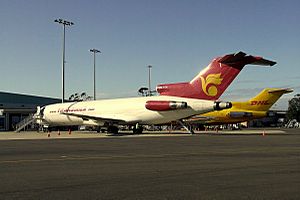
Terminal 2 is in the airport's north-eastern section. It used to be the main terminal for Ansett Australia's domestic flights. It has 15 parking bays with aerobridges and many non-contact bays. Today, it serves Virgin Australia, Jetstar, Tiger Airways, Regional Express Airlines, Aeropelican Air Services, and Qantaslink flights operated by Eastern Australia Airlines. There are lounges for Qantas, Virgin Australia, and Regional Express Airlines.
Terminal 3: Qantas Domestic Flights
Terminal 3 is a domestic terminal used mainly for Qantas and Qantaslink flights, including those to Canberra. It used to be the home for Trans Australia Airlines (later called Australian Airlines). Like Terminal 2, it is in the north-eastern section of the airport. The current terminal building was mostly built during expansions in the late 1990s. It has 14 parking bays with aerobridges, including two with double aerobridges for larger planes.
Terminal 3 has a large Qantas Club lounge, and special lounges for Business Class and Chairmans members. Terminal 3 also has a 'Heritage Collection' which shows items from Qantas's 90 years of service. It also has a great view of the airport and is popular with plane-spotters. It is located next to Gate 13.
Other Airport Areas
Sydney Airport once had a fourth passenger terminal, east of Terminal 2. This was known as Domestic Express. It was used by Regional Express Airlines, Virgin Blue (now Virgin Australia), and Impulse Airlines. Now, it is used as an office building by DHL Express and Tasman Cargo Airlines.
The Freight Terminal is north of Terminal 1. It is used for international cargo operations.
Airlines and Destinations
Many airlines fly to and from Sydney Airport. Here are some of them:
- AirAsia X
- Aircalin
- Air Canada
- Air China
- Air India
- Air New Zealand
- Air Niugini
- Air Vanuatu
- All Nippon Airways
- American Airlines
- Asiana Airlines
- British Airways
- Cathay Pacific
- China Airlines
- China Eastern Airlines
- China Southern Airlines
- Delta Air Lines
- Emirates
- Etihad Airways
- Fiji Airways
- Garuda Indonesia
- Hainan Airlines
- Hawaiian Airlines
- Japan Airlines
- Jetconnect
- Jetstar
- Korean Air Lines
- LAN Airlines
- Malaysia Airlines
- Philippine Airlines
- Qantas
- QantasLink
- Qatar Airways
- Singapore Airlines
- Thai Airways International
- Tigerair
- United Airlines
- Vietnam Airlines
- Virgin Australia
- Virgin Samoa
- Xiamen Airlines
Past Airlines
These airlines used to fly to Sydney:
- Aeroflot
- Aerolíneas Argentinas
- Air Austral
- Air France
- Air Paradise International
- Air Tahiti Nui
- Alitalia
- Ansett Australia
- AOM French Airlines
- Austrian Airlines
- Canadian Pacific Air Lines
- Freedom Air
- Hazelton Airlines
- Kiwi Travel International Airlines
- KLM Royal Dutch Airlines
- Lauda Air
- Lufthansa
- Northwest Airlines
- Martinair
- Middle East Airlines
- Olympic Airways
- Pan Am
- Polynesian Airlines
- South African Airways
- Trans Australia Airlines
- UTA French Airlines
- Virgin Atlantic
Cargo Airlines
Cargo airlines carry goods instead of passengers.
| Airlines | Destinations | Terminal |
|---|---|---|
| Cathay Pacific Cargo | Hong Kong, Melbourne | Freight |
| DHL Express operated by Tasman Cargo Airlines | Auckland | |
| Emirates SkyCargo | Dubai, Hong Kong, Singapore | Freight |
| FedEx Express | Guangzhou, los angeles, Honolulu | Freight |
| Korean Air Cargo | Guangzhou, Seoul-Incheon | Freight |
| MASkargo | Kuala Lumpur | Freight |
| Qantas Freight operated by Atlas Air | Hong Kong, Honolulu, Shanghai-Pudong | Freight |
| Qantas Freight operated by Express Freighters Australia | Auckland, Christchurch | Freight |
| Singapore Airlines Cargo | Singapore | Freight |
| Thai Airways Cargo | Bangkok | Freight |
| Toll Priority operated by Airwork | Brisbane, Melbourne | |
| UPS Airlines | Anchorage, Nadi, Honolulu, Los Angeles | Freight |
- Notes
- Even though some flights are international, they might leave from the domestic Terminal 2 and stop somewhere else first.
- Some flights might stop in another Australian city on the way to their final destination. However, airlines cannot sell tickets for passengers to travel only between Sydney and that Australian stop.
- Each of these freight companies has its own building at the airport and does not use the main International freight terminal.
Airport Curfew
In 1995, the Australian Government passed a law called "The Sydney Airport Curfew Act". This law limits the hours the airport can operate. It was put in place to reduce complaints about aircraft noise. The curfew stops jet planes from taking off or landing between 11 PM and 6 AM. Some special flights are allowed between 11 PM to midnight and 5 AM to 6 AM, as permitted by the law.
During bad weather, flights are often delayed. This can mean that people on late flights cannot travel on the planned day. As of 2009, four airlines had been fined for landing during the closed hours. The largest fine can be AU$550,000.
Getting To and From the Airport
By Train
You can reach the airport from the city by using the Airport Link underground train line. The International railway station is located under the International terminal. The Domestic railway station is under the car park between the domestic terminals (Terminal 2 and Terminal 3). These stations are part of the Cityrail network, but they are owned and run by Airport Link, a private company. Passengers have to pay an extra station fee, or 'gate fee', of $11.80. This fee is added to the price of the train ticket.
The trains that go to the airport are regular suburban trains. Unlike special airport trains in other cities, they do not have extra space for luggage. They also do not travel directly to the airport without stops. Sometimes, all seats might be taken by commuters before the trains reach the airport.
By Bus
Sydney Buses operates Route 400. This bus goes from Burwood to Bondi Junction railway stations and stops at both the International and Domestic terminals. It connects the eastern suburbs, Inner West, and St George areas to the airport.
By Road
Sydney Airport has road connections in all directions. Southern Cross Drive (M1) is a motorway that provides the fastest way to the city center. The only other motorway, the M5 South Western Motorway (which includes the M5 East Freeway), connects the airport with the south-western suburbs of Sydney.
There is a ring road around the airport. General Holmes Drive has a tunnel that goes under the main north-south runway and three taxiways. It also has an aircraft viewing area. Inside the airport, a partial ring road connects the Domestic Terminal with the control tower, the general aviation area (for smaller planes), car-rental company storage yards, the long-term car park, a heliport (for helicopters), various shops, and a hotel. A perimeter road runs inside the secure area for airport vehicles only.
The Airport has several official car parks:
- Domestic Short Term
- Domestic Remote Long Term
- International Short/Long Term.
There are also many private parking companies near the airport. They are usually cheaper than the official car parks and offer free shuttle buses to the airport.
Walking and Cycling
The International Terminal is next to a wide path for walking and cycling. This path connects Mascot and Sydney City in the north-east with Tempe (by a footbridge over Alexandra Canal) and Botany Bay to the south-west. All terminals have bicycle racks. They are also easy to reach on foot from nearby areas.
Accidents and Incidents
- On June 18, 1950, a Douglas DC-3 plane from Ansett Airways was getting ready to take off. It hit and derailed a coal train on a railway line that crossed the runway. Only the co-pilot was hurt.
- On November 30, 1961, Ansett-ANA Flight 325, a Vickers Viscount plane, crashed into Botany Bay shortly after taking off. The right wing broke after the plane flew into a thunderstorm. All 15 people on board died.
- On December 1, 1969, Boeing 707-321B N892PA of Pan Am Flight 812 went off the end of the runway during takeoff. This happened because of bird strikes (when birds hit the plane). Engine number 2 was damaged and lost power. The takeoff was stopped. The plane stopped about 170 meters (560 feet) beyond the end of runway 34 (now runway 34L). During the crash, engine number 2 hit the ground and was damaged. The front and left main landing gears broke. The plane came to rest supported by engines 1 and 2, the nose, and the rest of the main landing gear. None of the 125 passengers and 11 crew members were injured.
- On February 21, 1980, VH-AAV, a Beechcraft Super King Air plane, took off from Sydney Airport and had an engine failure. The pilot flew the plane back to the Airport and tried to land but crashed into the sea wall. All 13 people on board died in the accident.
- On April 24, 1994, Douglas DC-3 VH-EDC of South Pacific Airmotive had an engine failure soon after taking off. It was on a charter flight to Norfolk Island. The plane landed in Botany Bay. All four crew members and 21 passengers were safely rescued.
Images for kids
-
Tail of a Qantas Boeing 747 at Sydney Airport with the skyline of Sydney in the background.
See also
 In Spanish: Aeropuerto Internacional Kingsford Smith para niños
In Spanish: Aeropuerto Internacional Kingsford Smith para niños


